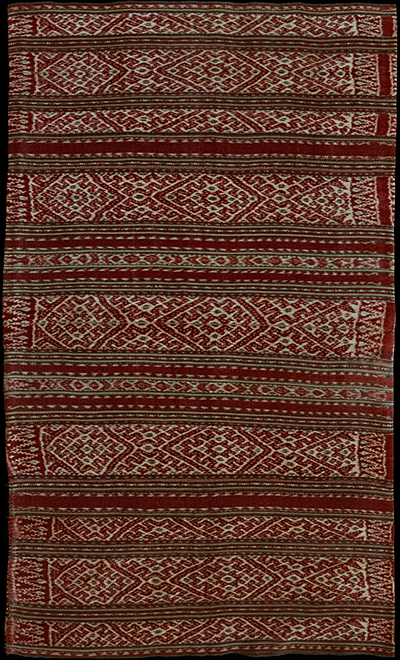| |
 
 | | | |
207 Timor, West Timor
Tais (sarong)  
| | Locale: | Amarasi, Oekabiti clan. | | Period: | 1920-1940 | | Yarn: | Cotton, hand-spun and commercial | | Technique: | Warp ikat | | Panels: | 3 | | Size: | 62.5 x 101 cm (2' 0" x 3' 3") LW: 1.62 | | Weight: | 460 g (16.2 oz), 364 g/m2 (1.19 oz/ft2) | | Design: | Entire field decorated with ikated bands in white on morinda red, showing the kai e'ne or kaif motif that stands for connection to the ancestors, in a form that is typical for the Oekabiti clan. The middle panel carries two kai e'ne, the two side panels each one whole and two halves turned outward. Tiny accents in a greenish pale indigo. Narrow accent stripes in black and white sotis (float weave), pinstripes in commercial yarn - common in Timor since the early 20th C. - dyed however with the same vegetable dyes used on the rest of the cloth. | | Comment: | Traditional Amarasi ceremonial sarong. Tight patterning, indicating the hand of a master weaver. The three panels have been joined so carefully that the seam is barely visible, and more easily discovered by stroking the cloth. Curiously, the wider ikat bands have been done in double-ply commercial cotton, the narrow stripes in hand spun thread, the pinstripes, only a few threads wide, in commercial thread that appears to have been coloured with vegetable dyes | | Background: | Chapters on Timor and West Timor. | | Exhibited: | Timor: Totems and Tokens, Museu do Oriente, Lisbon, 2019/20. | | Published: | Ikat Textiles of the Indonesian Archipelago, 2018.
Timor: Totems and Tokens, 2019.
Ikat Textiles of Timor: Indonesian and Timor-Leste, 2025. | | Compare: | 192 | | Sources: | Very similar to Amarasi tais from Oekabiti in Yeager and Jacobson, Textiles of Western Timor, Plate 8. Characteristic fine stripes in commercial yarn that separate the ikated bands very similar to those in detail shots on Plates 6 and 7. Nearly identical to sarong in Khan Majlis, Woven Messages, Fig. 252. Very similar sarong tais worn by high class women on her 'coming out' ceremony after childbirth on early 20th C. photo in Gittinger, Splendid Symbols, Fig. 9. | | |

©Peter ten Hoopen, 2025
All rights reserved.
|
|


